ISSN ONLINE(2319-8753)PRINT(2347-6710)
ISSN ONLINE(2319-8753)PRINT(2347-6710)
Navin Saw1 and D.U.Gopekar2
|
Visit for more related articles at International Journal of Innovative Research in Science, Engineering and Technology
Conversion cost is the cost required to convert Raw material into finished goods. As the conversion cost is less profits can be increased and it will also help to be competitive in the market. Cost management is the key to survival in a competitive global industry. The quantity of resin converted per year is a good indicator of the capacity of a plastic converter, which is associated with the converting technology in place. It allows interesting comparisons, and should reflect purchasing capabilities as well as potential for economy of scale. This project deals with waste utilization and energy analysis in terms of cost of the stretching process of bi-axially oriented polypropylene films using a hot oil coiler along with stretching unit. Efficient energy use is critical for the success of any industrial facility since reduced energy consumption through energy conservation/saving programs can benefit not only consumers and utilities, but society in general as well. This is very important for companies having cost structures that are highly dependent upon the relative importance of the cost of raw materials, particularly for extrusion-oriented converters active in film making or in sheet manufacturing.
Keywords |
| Waste, TDO, BOPP, RPG |
INTRODUCTION |
| BOPP means biaxially oriented polypropylene film which is made up of polypropylene resin. The manufacture of flat film includes a two stage direction stretching process. First stretch in longitudinal direction and second in transverse direction in order to improve its mechanical properties. |
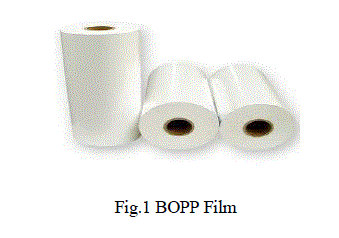 |
| BOPP film is one of the most popular raw materials of flexible packaging industry in the world. Lower costs and convenience has added to the growth of BOPP in the past few years, along with other flexible packaging materials. Moreover, the growth in demand for this film has been substantial both in developed as well as emerging markets on account of its recyclable nature and application in a variety of non- food and food products. BOPP films are ideal for twist-wrap application and in lamination for use on vertical and horizontal machines. BOPP films are used in an a almost limitless array of flexible packaging, pressure sensitive tapes, labels, stationery, metalizing, consumer products and a wide variety of packaging uses. The BOPP film production is based on raw material to be proportioned, mixed and polymerized to produce final product. The BOPP film production plant requires a main processing phase in the following production line order. |
| a. Raw material feeding and dosing unit |
| b. Extrusion unit |
| c. Film casting unit |
| d. MDO ( machine direction orientation) |
| e. TDO ( transverse direction orientation) |
| f. PRS ( pull roll stand) |
| g. Winder unit |
| This is overall introductory information about BOPP film producing plant. |
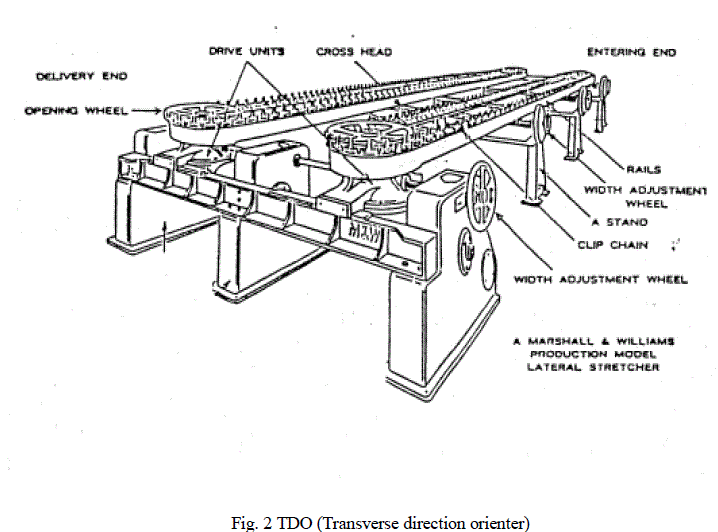 |
| The concept of oil heating in TDO was first introduced by Brueckner Maschinenbau Gmbh, Siegsdorf, Germany [1] has discovered a comprehensive package of ground-breaking energy saving concepts. During numerous conversations with plastic experts, Bruckner identified repeatedly the same challenge for the future: with regard to the price caprioles in energy supply, a change of views in industry is inevitable. Of course, Bruckner is already ahead of the industry with environmentally friendly systems using “green” solutions across the whole film stretching line. And by the way, saving money is Bruckner offers an energy audit which discloses energy saving potentials at the line. One of the most efficient ways of saving energy and money in the film stretching process is to focus on the biggest energy consumer within the system: the transverse direction orientation (TDO) unit. Heat recovery on the TDO unit leads to tremendous energy saving by recycling the heat of the exhaust air through a heat exchanger and preheating the fresh air required. Not only does this efficient way of using rejected heat save energy; due to the preheated fresh air less condensate is accumulated in the TDO unit, which leads to a higher film quality and to less maintenance. Replacing all electric heating systems of the TDO unit on older lines with a combined oil/electric unit reduces operating costs dramatically. Electrical heating is used during TDO start-up to shorten heat-up time; afterwards during production, the less expensive oil heating starts. This technology enables a saving of about 60% in heating energy costs. M.Tolga Balta and Arif Hepbasli, Ebru Hancioglu, Ertan Yilmazer [2], This paper deals with an exergy analysis of the stretching process of bi-axially oriented polypropylene films using a hot oil coiler along with stretching and crystallizing unit, Exergy destructions and efficiencies in each of the system components are calculated, while the exergy loss and the flow diagram (the so-called Grossmann diagram) is presented for the transverse direction (TD) unit. The so called functional (on the product or benefit/fuel basis) and universal(on the output/inputs basis) exergy efficiency values of the TD unit are calculated to be 26.40% and 28.46% at recommended exhaust air relative humidity of 0.0098kg water/kg air, respectively. In [3], The author explains the energy and energy analysis to indentify the locations and magnitudes of losses in order to maximize the performance of a 500kw open system steam power plant at BOPP. Thermodynamics systems are analyzed using two essential tools (The Energy and Energy Analysis).However, system analysis based on the energy law (quantity) alone is deceptive, because the exergy law shows that energy has quantity as well as quality. The required outputs (work, heat and irreversibility) of the various components are assessed and calculated using mass, energy,and energy balance equations. The results indicate that about 50% of the heat energy generated in the combustor is destroyed. In conclusion, further improvement in the combustor will maximize the plant performance hence the results show how energy and exergy have been used to locate places of inefficiencies in the plant. In [4],The author examines the relationship between futures and spot prices for energy commodities. Moss, S., Pauquet J-R., Zweifel, H. [4], has discovered Degradation and Stabilization of Polyolefin During Melt Processing. |
| The work in this paper is divided in two stages. 1) RPG utilization 2) Alternate Power Resources in TDO unit. During the manufacturing of BOPP films due to problems in the process or quality waste is generated. Company has their own plant to convert waste into raw material form which is called RPG (Reprocessed Granules). The quality of recyclates is recognized as one of the principal challenges that needs to be addressed for the success of a long term vision of a green economy and achieving zero waste. Recyclate quality is generally referring to how much of the raw material is made up of target material compared to the amount of non-target material and other non- recyclable material Only target material is likely to be recycled, so a higher amount of non-target and non-recyclable material will reduce the quantity of recycling product. The amount of money actually saved through recycling depends on the efficiency of the recycling program used to do it. The transverse direction orienting machine is abbreviated as “ TDO”, standing for transverse direction. The TDO is to stretch the film in transverse direction which is already longitudinal oriented film in transverse direction. The film is transported through clip which are fixed on TDO chain. There are three section of TDO.(Preheating Section, Stretching Section, Cooling Section). The spindles are provided at the operator side of the TDO for adjusting the width of the film. There are 15 numbers of spindles, in which first 6 spindles for preheating; next 5 for Stretching and last 6 for annealing are used. The maximum stretching is occurred at spindles number 9 and maximum width after annealing is 8200mm.On the top of the TDO an exhaust system is installed to eliminate vapours, originating from additives from the oven. |
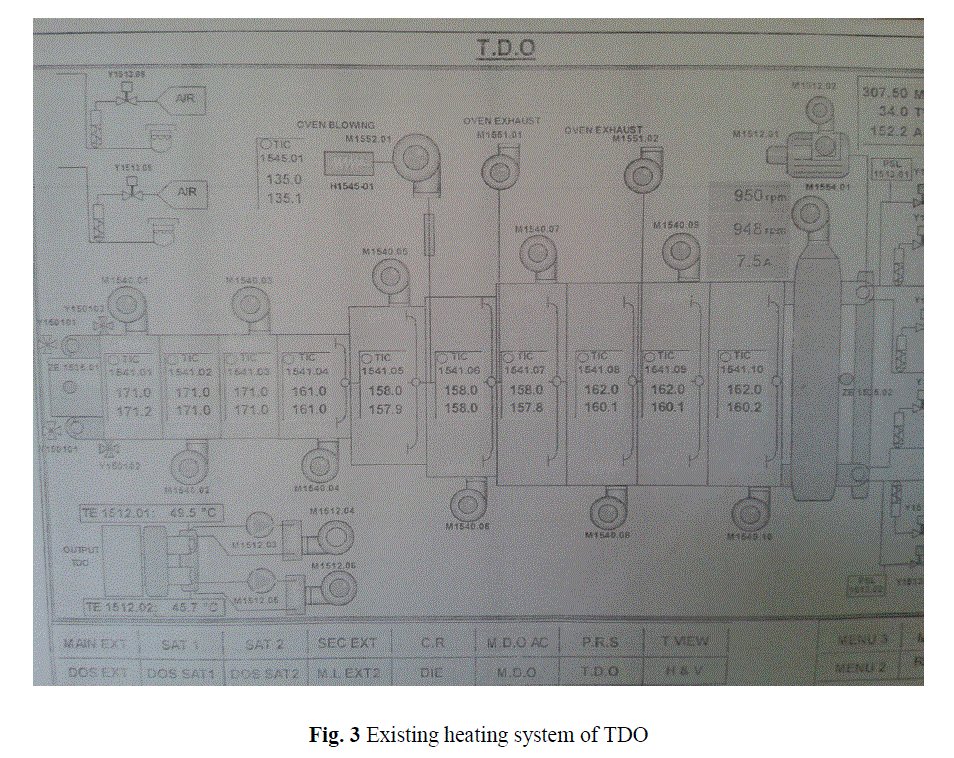 |
EXISTING HEATING SYSTEM OF TDO |
| The heating required for stretching is provided by electrical. Basically transverse direction orientation is process carried out in big oven type structure, which is divided into ten different sections. Each section is been provided with blower and heater. Which provides hot air to maintain the required temperatures in each zone? The blowers are installed at operator side as well as drive side for blowing the air. This air is heated by the heat exchanger (Rectangular block). At the end of the oven cooling blowers are installed to cool down the hot film. |
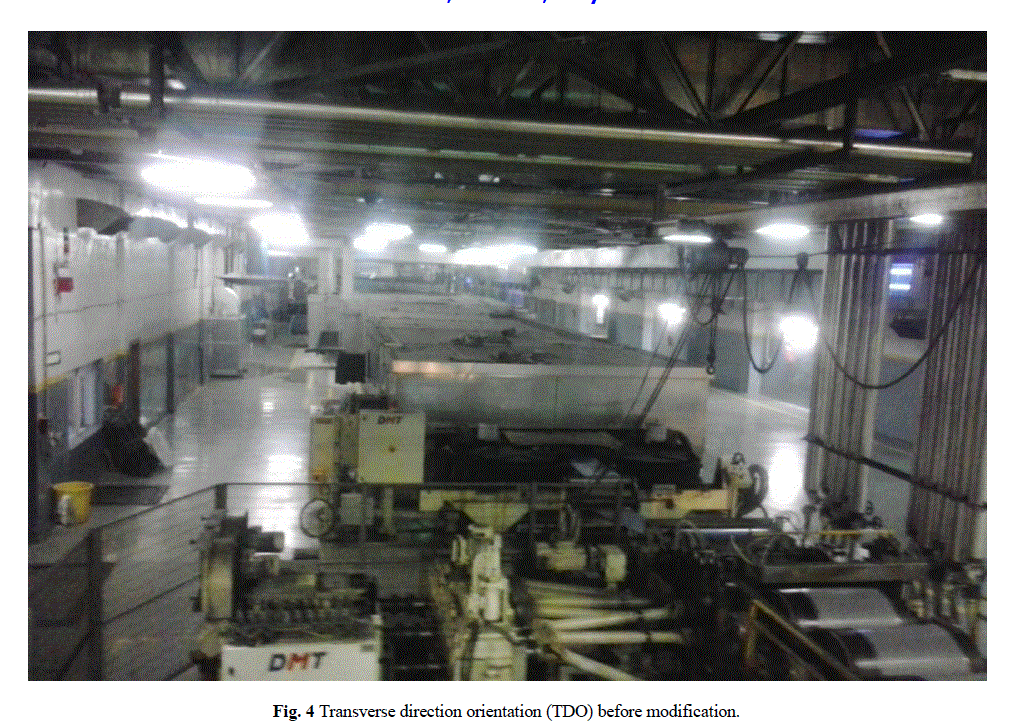 |
METHODOLOGY |
| 1)During the experiment, in process of BOPP manufacturing RPG will be added in varying percentage of utilization. The RPG generated from the type of film is same utilized in that product. Such as: RPG of plain film in making of plain films applied for same such as white RPG for making white films etc. |
| 2) Due to continuous increase in the rates of electricity company has now decided to opt for oil heating instead of electrical heating for high electricity consuming equipments. The manufacturing process of BOPP films has a process called TDO (Transverse Direction Orientation) where the film is passed through a oven and the electrical heating is provided to the heaters and it consumes major part of electricity required so to save the electricity an additional unit (a tubular structure) has to be provided instead of electrical heaters. |
| The basic logic of the operation modification is REVERSE ENGINEERING whereas company having BOPP production lines from two different manufacturers. |
| -DMT from France |
| -Bruckner from Germany. |
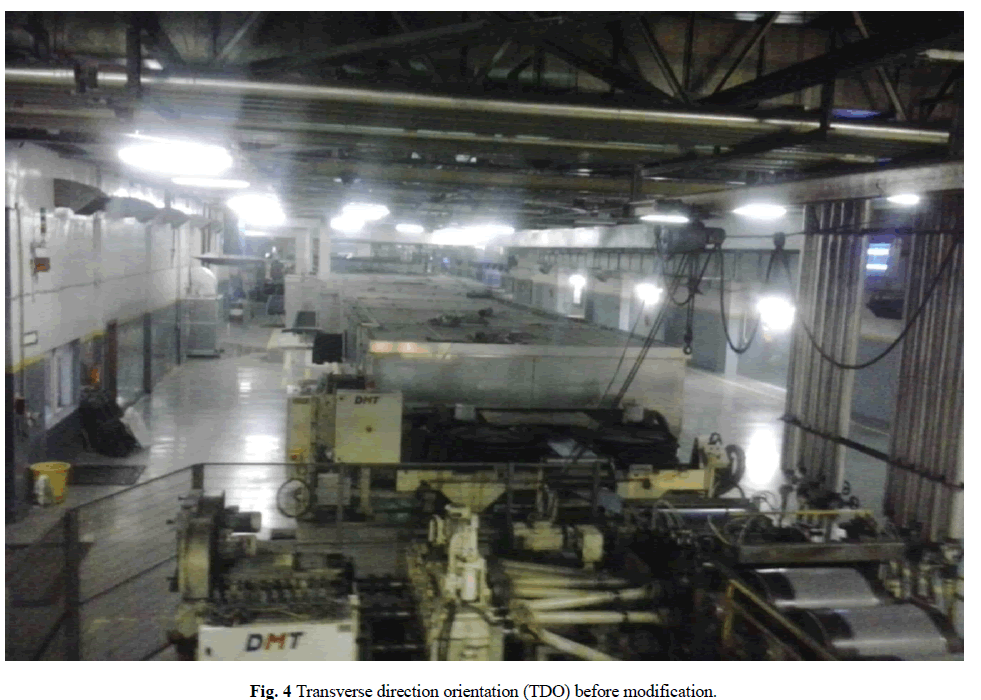 |
| So it is observed that the heating for TDO unit in Bruckner lines is provided by oil heating and by electrical heating in DMT lines. |
| As heated oil is been utilized at various places for heating purpose with certain modification to DMT lines oil heating can be started with utilizing current oil. So except modification investment no other investment is needed. |
RESULT AND DISCUSSION |
| During RPG utilization Results will be measured in terms of impact on quality and process. The impact on process will be analysed by comparing the waste generated by inclusion of RPG and waste without RPG. For quality impact rejection is a parameter of measurement of both cases. Now depending on the comparisons of waste and rejections the percentage of RPG utilization will be finalized. And the amount of RPG utilized in terms of Kg and price difference between the raw material and RPG cost is savings and will result into profits. |
| Data of per month RPG utilization format in month wise is given below. |
 |
| After implementing oil heating in TDO unit the amount of electricity saved in terms of units *cost per unit will be savings. |
CONCLUSION |
| This Study presents theoretical reutilizing waste & existing heating system of TDO. Now we have to add RPG in varying percentage & implement oil heating in TDO instead of electrical heating. All these savings will result in reduced conversion cost of product. |
References |
|